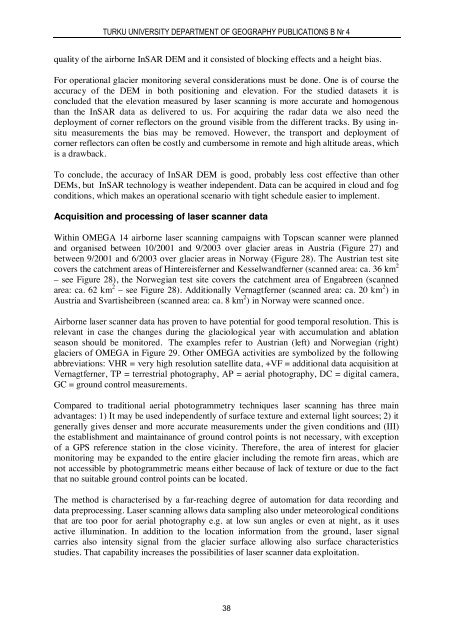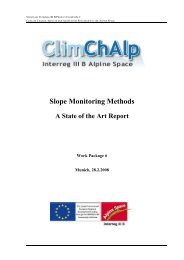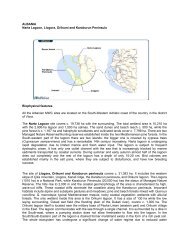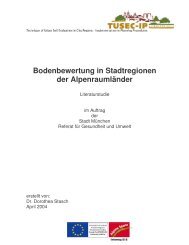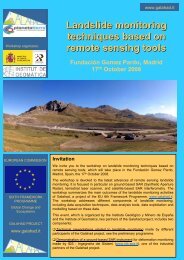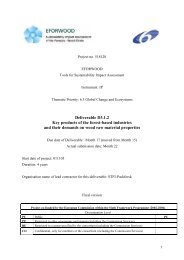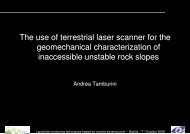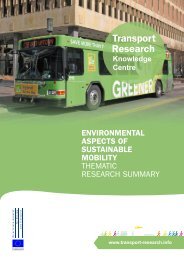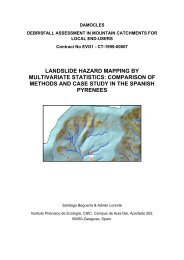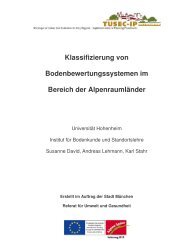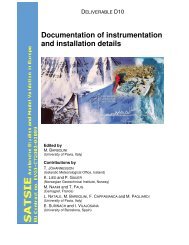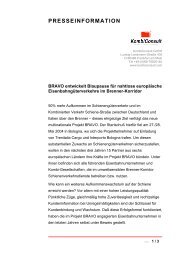1 Background - mountain.PROJECTS
1 Background - mountain.PROJECTS
1 Background - mountain.PROJECTS
Create successful ePaper yourself
Turn your PDF publications into a flip-book with our unique Google optimized e-Paper software.
TURKU UNIVERSITY DEPARTMENT OF GEOGRAPHY PUBLICATIONS B Nr 4quality of the airborne InSAR DEM and it consisted of blocking effects and a height bias.For operational glacier monitoring several considerations must be done. One is of course theaccuracy of the DEM in both positioning and elevation. For the studied datasets it isconcluded that the elevation measured by laser scanning is more accurate and homogenousthan the InSAR data as delivered to us. For acquiring the radar data we also need thedeployment of corner reflectors on the ground visible from the different tracks. By using insitumeasurements the bias may be removed. However, the transport and deployment ofcorner reflectors can often be costly and cumbersome in remote and high altitude areas, whichis a drawback.To conclude, the accuracy of InSAR DEM is good, probably less cost effective than otherDEMs, but InSAR technology is weather independent. Data can be acquired in cloud and fogconditions, which makes an operational scenario with tight schedule easier to implement.Acquisition and processing of laser scanner dataWithin OMEGA 14 airborne laser scanning campaigns with Topscan scanner were plannedand organised between 10/2001 and 9/2003 over glacier areas in Austria (Figure 27) andbetween 9/2001 and 6/2003 over glacier areas in Norway (Figure 28). The Austrian test sitecovers the catchment areas of Hintereisferner and Kesselwandferner (scanned area: ca. 36 km 2– see Figure 28), the Norwegian test site covers the catchment area of Engabreen (scannedarea: ca. 62 km 2 – see Figure 28). Additionally Vernagtferner (scanned area: ca. 20 km 2 ) inAustria and Svartisheibreen (scanned area: ca. 8 km 2 ) in Norway were scanned once.Airborne laser scanner data has proven to have potential for good temporal resolution. This isrelevant in case the changes during the glaciological year with accumulation and ablationseason should be monitored. The examples refer to Austrian (left) and Norwegian (right)glaciers of OMEGA in Figure 29. Other OMEGA activities are symbolized by the followingabbreviations: VHR = very high resolution satellite data, +VF = additional data acquisition atVernagtferner, TP = terrestrial photography, AP = aerial photography, DC = digital camera,GC = ground control measurements.Compared to traditional aerial photogrammetry techniques laser scanning has three mainadvantages: 1) It may be used independently of surface texture and external light sources; 2) itgenerally gives denser and more accurate measurements under the given conditions and (III)the establishment and maintainance of ground control points is not necessary, with exceptionof a GPS reference station in the close vicinity. Therefore, the area of interest for glaciermonitoring may be expanded to the entire glacier including the remote firn areas, which arenot accessible by photogrammetric means either because of lack of texture or due to the factthat no suitable ground control points can be located.The method is characterised by a far-reaching degree of automation for data recording anddata preprocessing. Laser scanning allows data sampling also under meteorological conditionsthat are too poor for aerial photography e.g. at low sun angles or even at night, as it usesactive illumination. In addition to the location information from the ground, laser signalcarries also intensity signal from the glacier surface allowing also surface characteristicsstudies. That capability increases the possibilities of laser scanner data exploitation.38


